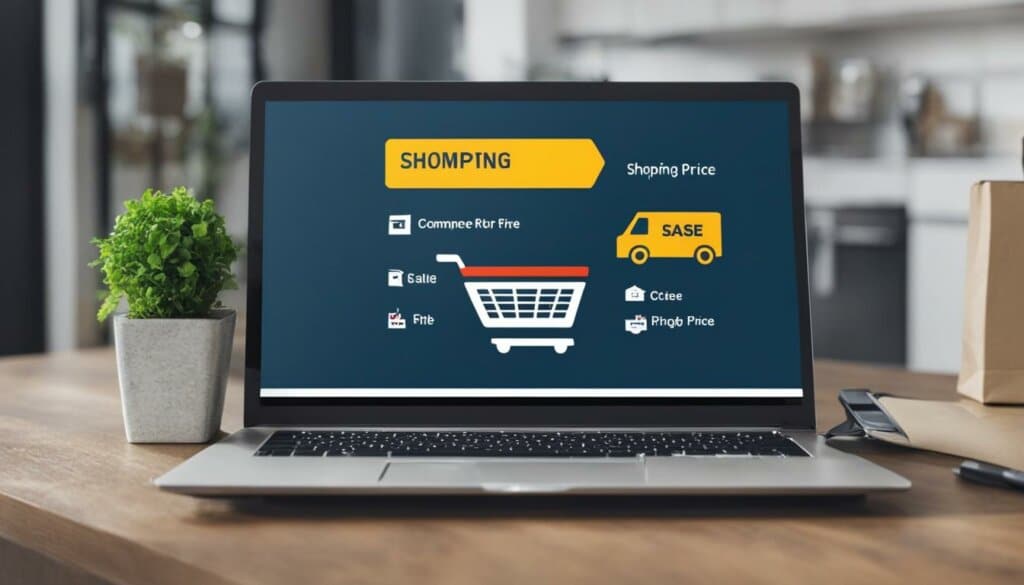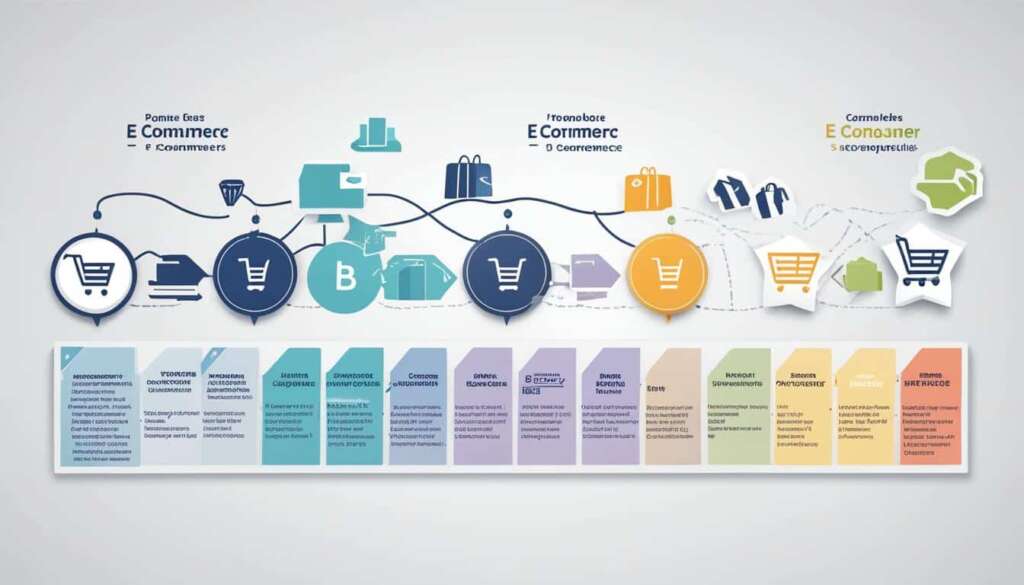Table of Contents
Let’s start by delving into the world of e-commerce, or electronic commerce, which has transformed the way we buy and sell goods and services. With the advent of the internet, businesses have embraced online platforms to reach customers globally and facilitate transactions. E-commerce encompasses various online business models, including business-to-business (B2B), business-to-consumer (B2C), consumer-to-consumer (C2C), and consumer-to-business (C2B).
E-commerce has experienced remarkable growth in recent years, with giants like Amazon and eBay leading the charge. In 2011, e-commerce accounted for 5% of total retail sales globally. However, with the COVID-19 pandemic, the share of e-commerce in total retail sales has soared to 16.5%. This surge can be attributed to the convenience, availability, and wide selection that e-commerce offers.
E-commerce acts as a digital marketplace, providing customers with round-the-clock access to a vast range of products and services. It allows businesses to expand their reach beyond geographical boundaries, tapping into the global market. With just a few clicks, customers can explore and purchase products from the comfort of their homes, enabling a seamless shopping experience. E-commerce is not only transforming the retail industry but also reshaping consumer behavior and expectations.
To better understand the essentials of e-commerce and build a successful online business, let’s explore how it works, the different types of e-commerce, its advantages, and disadvantages. By gaining a comprehensive understanding of the e-commerce landscape, you can stay ahead in the ever-evolving world of online retail.
How Does E-Commerce Work?
E-commerce, a fundamental aspect of the electronic network, operates primarily on the internet. Online stores serve as the platform for customers to access and browse a wide range of products, ultimately placing orders. The process begins when customers use their devices to access the website of an online store.
Once customers have found the desired products, they initiate the order process. This involves the web browser communicating with the server hosting the e-commerce website. The order data is then transmitted to an order manager, which interacts with databases to manage inventory levels and payment information.
Upon successful validation of the order, the order manager triggers a notification to the web server. The server responds by displaying a confirmation message to the customer, ensuring a seamless shopping experience. Subsequently, the order data is transmitted to the warehouse or fulfillment department for the timely dispatch of products or provision of services.
Types of E-Commerce
When it comes to e-commerce, there are various business models that shape the way transactions are conducted online. Understanding these different types can help businesses navigate the digital landscape and tailor their strategies accordingly.
B2B (Business-to-Business)
B2B e-commerce involves transactions between businesses. This model is commonly used when businesses need to purchase goods or services from suppliers or wholesalers. It enables companies to streamline their procurement processes and conduct transactions online, reducing costs and improving efficiency.
B2C (Business-to-Consumer)
B2C e-commerce focuses on selling products or services directly to consumers. This is the most common model, with businesses setting up online stores to reach and serve a wide consumer base. B2C e-commerce allows businesses to showcase their products, offer personalized shopping experiences, and provide convenience and accessibility to customers.
C2C (Consumer-to-Consumer)
C2C e-commerce involves consumers trading products or services with each other through online platforms. This model facilitates peer-to-peer transactions, allowing individuals to buy and sell items directly to other consumers. Popular C2C platforms like eBay and Etsy enable users to create listings, engage in bidding, and complete transactions in a secure environment.
C2B (Consumer-to-Business)
C2B e-commerce allows consumers to make their products or services available for businesses to purchase. This model is often seen in freelance marketplaces, where individuals offer their skills or expertise to businesses looking to outsource specific tasks or projects. C2B e-commerce empowers consumers to monetize their assets or talents and provides businesses with flexible and cost-effective solutions.
Online Marketplaces
Online marketplaces play a crucial role in e-commerce, acting as intermediaries between buyers and sellers. These platforms provide a venue for various types of transactions, including B2B, B2C, and C2C. Marketplaces like Amazon, eBay, and Alibaba connect sellers with a vast customer base and offer features such as secure payment processing, customer reviews, and logistics support.
Service Businesses
E-commerce is not limited to the sale of physical products. Service businesses, government bodies, and public administrations can also participate in online transactions. This is known as B2A (Business-to-Administration) and C2A (Consumer-to-Administration), where businesses and consumers interact with government or administrative entities through digital channels.
Advantages of E-Commerce
E-commerce offers several advantages that have made it a preferred choice for businesses and consumers alike. Let’s explore some of these benefits:
Around-the-Clock Availability
E-commerce provides customers with the convenience of browsing and shopping at any time. Unlike physical stores with fixed operating hours, e-commerce sites are accessible 24/7. This availability allows customers to make purchases whenever it fits their schedule, contributing to a seamless shopping experience.
Speed of Access
With e-commerce, customers can quickly access products and services through user-friendly interfaces. Browsing, shopping cart, and checkout pages load within seconds, ensuring a smooth and efficient shopping process. This speed of access enhances customer satisfaction and encourages repeat purchases.
Wide Selection
E-commerce platforms offer a vast range of goods and services, providing customers with a wide selection to choose from. Online retailers can stock an extensive inventory without the physical space limitations faced by brick-and-mortar stores. Customers can explore various options and find the products that best meet their needs and preferences.
International Reach
E-commerce transcends geographical boundaries, allowing businesses to expand their customer reach globally. With a strong online presence, businesses can sell their products and services to anyone with internet access, irrespective of their location. This international reach opens up new markets and growth opportunities for businesses.
Overall, the availability, accessibility, speed of access, wide selection, and international reach offered by e-commerce have revolutionized the way businesses operate and customers shop.

| Advantages | Description |
|---|---|
| Around-the-Clock Availability | Customers can browse and shop at any time, as e-commerce sites are accessible 24/7. |
| Speed of Access | E-commerce platforms provide fast loading times for browsing, shopping cart, and checkout pages. |
| Wide Selection | Online retailers offer a vast range of products and services, catering to diverse customer preferences. |
| International Reach | E-commerce enables businesses to sell to customers worldwide, transcending geographical boundaries. |
Disadvantages of E-Commerce
While e-commerce offers numerous advantages, it is not without its downsides. It is important for businesses and consumers alike to understand and consider these disadvantages when engaging in online transactions.
Limited Customer Service
The limited customer service provided by e-commerce platforms can be a significant drawback. Customers typically only have access to online support, which may be difficult to navigate or insufficient for specific queries. The lack of immediate assistance and personalized interaction can leave customers feeling frustrated and dissatisfied.
Inability to Physically See or Touch Products
One major disadvantage of e-commerce is the inability to physically see or touch products before making a purchasing decision. This can lead to uncertainty and dissatisfaction if the product does not meet the customer’s expectations upon arrival. While detailed product descriptions and images can help mitigate this issue, some customers may still prefer the tactile experience of traditional retail.
Wait Time for Product Delivery
An inherent aspect of e-commerce is the wait time for product delivery. While shipping times have improved over the years, there is still a delay between placing an order and receiving the product. This wait can be frustrating for customers who are accustomed to immediate gratification and can lead to impatience or even order cancellations.
Security Concerns
Security concerns present a significant challenge for e-commerce. The risk of fraudulent websites, data breaches, and payment risks can deter customers from engaging in online transactions. Privacy and security are ongoing concerns, requiring businesses to prioritize robust security measures to protect customer information and foster trust.
“The convenience of e-commerce comes at a price. While it offers unparalleled accessibility and convenience, the limitations in customer service, inability to physically experience products, wait time, and security concerns are facts that businesses and consumers must consider when embracing e-commerce.”
Disadvantages of E-Commerce
| Disadvantage | Explanation |
|---|---|
| Limited Customer Service | Customers may only have access to online support, which may be difficult to navigate or insufficient for specific questions. |
| Inability to Physically See or Touch Products | Customers cannot physically examine products before purchase, leading to potential dissatisfaction if the product does not meet expectations. |
| Wait Time for Product Delivery | E-commerce typically involves a waiting period between placing an order and receiving the product, despite improved shipping times. |
| Security Concerns | Customers face risks such as fraudulent websites, data breaches, and payment risks, impacting their trust and confidence in e-commerce. |
Despite the disadvantages, e-commerce continues to revolutionize the retail landscape, offering unparalleled convenience and accessibility in the digital age. By addressing these challenges and implementing appropriate strategies, businesses can mitigate the downsides and provide a seamless online shopping experience for their customers.
The Rise of E-Commerce
The COVID-19 pandemic has had a profound impact on the world, reshaping various industries and accelerating the growth of e-commerce. As people faced lockdowns and health concerns, online shopping became the go-to solution. This shift in consumer behavior has resulted in the unprecedented rise of online businesses and the digital marketplace.
With the increasing reliance on e-commerce, it is projected that there will be over 2 billion digital buyers worldwide in 2020. This surge in online shoppers highlights the importance of establishing a strong online presence to capture this expanding market.
The value of global e-commerce retail sales has been steadily increasing as well, reaching $2.84 trillion in 2018. This figure is projected to grow even further, with an estimated value of $4.88 trillion by 2021. The exponential growth of e-commerce has disrupted the traditional retail industry and forced businesses to adapt or face significant challenges.
The rise of mobile commerce, or m-commerce, has also played a major role in the e-commerce boom. With the widespread use of smartphones and tablets, consumers prefer the convenience of making purchases anytime, anywhere. Mobile devices have become the primary means of accessing online shopping platforms, further fueling the growth of e-commerce.
“The COVID-19 pandemic has accelerated the growth of e-commerce, creating vast opportunities for online businesses worldwide.”
E-commerce has not only transformed the way consumers shop but has also presented numerous opportunities for businesses to thrive in the digital landscape. As the world continues to navigate the challenges posed by the pandemic, online businesses are well-positioned to meet the changing needs and preferences of consumers.
| Year | Global E-Commerce Retail Sales |
|---|---|
| 2018 | $2.84 trillion |
| 2021 (Projected) | $4.88 trillion |
Table: Global E-Commerce Retail Sales
The rise of e-commerce has revolutionized retail, bringing both challenges and opportunities for businesses worldwide. To remain competitive in this rapidly evolving digital landscape, companies must harness the power of e-commerce, adapt to consumer preferences, and capitalize on the global reach and potential of online business.
Essential Elements for Building a Successful E-Commerce Business
Building a successful e-commerce business requires mastering several essential elements. Let’s dive into the key components that contribute to a thriving online venture.
1. Brand Identity
Establishing a strong brand identity is crucial for setting your e-commerce business apart from competitors. It helps create a positive perception in the minds of consumers and builds trust. Consistent branding across your website, product packaging, and marketing materials will reinforce your brand identity and leave a lasting impression.
2. User-friendly Design
A user-friendly website design is essential for enhancing the shopping experience and driving customer satisfaction. Your website should have a clean and intuitive interface, making it easy for customers to navigate and find what they need. Clear product categorization, prominent search functionality, and a well-structured layout contribute to a seamless user experience.
3. Mobile-friendly Website
With a significant portion of online transactions happening on mobile devices, optimizing your e-commerce website for mobile is imperative. A mobile-friendly design ensures that your site is responsive and easily accessible across various screen sizes. This enables customers to browse, shop, and complete purchases effortlessly, regardless of the device they’re using.
4. High-quality Product Images
Visual appeal plays a crucial role in attracting customers and influencing their purchasing decisions. Use high-quality product images that showcase your offerings from different angles and perspectives. Clear and detailed visuals enable customers to make informed choices and provide a closer representation of the product they’ll receive.
5. Customer Reviews
Customer reviews act as social proof, influencing other shoppers’ buying decisions. Displaying genuine customer feedback helps build trust and credibility. Encourage customers to leave reviews after their purchases and prominently feature them on your website. Positive reviews can boost sales, while negative ones provide opportunities for improvement and showcase your commitment to customer satisfaction.
6. Streamlined Checkout Process
A streamlined checkout process is crucial for minimizing cart abandonment and ensuring a smooth transaction for customers. Simplify the checkout flow by reducing the number of steps required and eliminating unnecessary distractions. Offer various secure payment options, clearly display shipping costs and delivery estimates, and provide a transparent summary of the customer’s order.
Key Takeaways
Building a successful e-commerce business involves paying attention to key elements such as brand identity, user-friendly design, mobile optimization, high-quality product images, customer reviews, and a streamlined checkout process. By prioritizing these factors, you can create a compelling online shopping experience that attracts customers, boosts conversions, and sets your business up for success.
Conclusion
Mastering the basics of e-commerce is crucial for building a successful online retail business. Understanding the different types of e-commerce, how it works, and its advantages and disadvantages is essential for navigating the competitive industry. The rise of e-commerce, especially amidst the COVID-19 pandemic, presents significant opportunities for businesses to thrive online. By focusing on essential elements such as brand identity, user-friendly website design, mobile optimization, high-quality product images, customer reviews, and a streamlined checkout process, online retailers can enhance the overall shopping experience and increase their chances of success.
Continual refinement and optimization of these elements are key to carving a space in the ever-evolving e-commerce landscape. Embracing the e-commerce basics and leveraging its potential can help businesses establish a strong online presence and drive growth. With proper execution and a customer-centric approach, businesses can create a successful online retail business that captures the attention and loyalty of consumers. By staying up-to-date with industry trends and consistently delivering value to customers, businesses can thrive in the exciting world of e-commerce.
FAQ
What is e-commerce?
E-commerce, short for electronic commerce, refers to the buying and selling of goods and services over the internet.
What are the different types of e-commerce?
There are various online business models and transactions in e-commerce, including business-to-business (B2B), business-to-consumer (B2C), consumer-to-consumer (C2C), and consumer-to-business (C2B).
How does e-commerce work?
E-commerce relies on the internet as its primary platform, where customers access online stores through their devices to browse products and place orders. The order process involves communication between the customer’s web browser and the server hosting the e-commerce website.
What are the advantages of e-commerce?
E-commerce offers advantages such as around-the-clock availability, quick access to products and services, a wide selection, and international reach.
What are the disadvantages of e-commerce?
Some disadvantages of e-commerce include limited customer service, inability to physically see or touch products before purchase, wait time for product delivery, and security concerns.
How has the COVID-19 pandemic impacted e-commerce?
The COVID-19 pandemic has accelerated the growth of e-commerce as people turned to online shopping due to lockdowns and health concerns. Online businesses have flourished, and there is a significant increase in digital buyers.
What are the essential elements for building a successful e-commerce business?
Building a successful e-commerce business requires elements such as a strong brand identity, user-friendly website design, mobile optimization, high-quality product images, customer reviews, and a streamlined checkout process.
How can I build a successful online retail business?
To build a successful online retail business, it is crucial to understand the basics of e-commerce and leverage the opportunities it offers. Focusing on essential elements such as brand identity, website design, mobile optimization, product images, customer reviews, and a streamlined checkout process can contribute to success.













